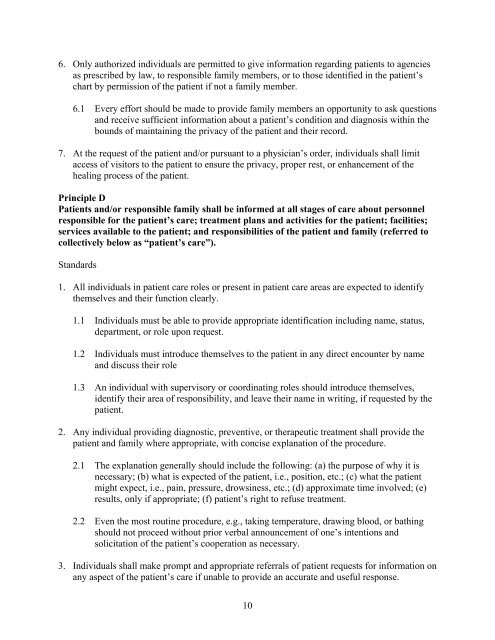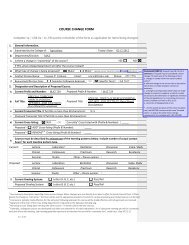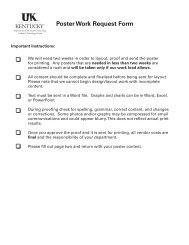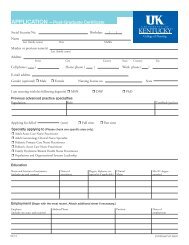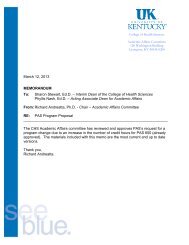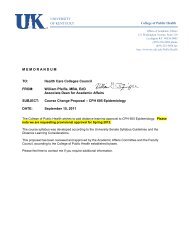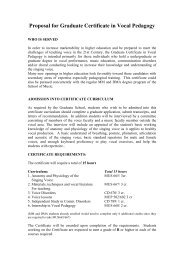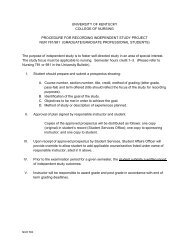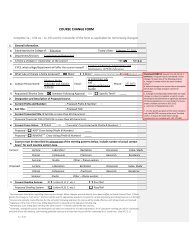05-06 Graduate Student Handbook.pdf - University of Kentucky
05-06 Graduate Student Handbook.pdf - University of Kentucky
05-06 Graduate Student Handbook.pdf - University of Kentucky
Create successful ePaper yourself
Turn your PDF publications into a flip-book with our unique Google optimized e-Paper software.
6. Only authorized individuals are permitted to give information regarding patients to agencies<br />
as prescribed by law, to responsible family members, or to those identified in the patient’s<br />
chart by permission <strong>of</strong> the patient if not a family member.<br />
6.1 Every effort should be made to provide family members an opportunity to ask questions<br />
and receive sufficient information about a patient’s condition and diagnosis within the<br />
bounds <strong>of</strong> maintaining the privacy <strong>of</strong> the patient and their record.<br />
7. At the request <strong>of</strong> the patient and/or pursuant to a physician’s order, individuals shall limit<br />
access <strong>of</strong> visitors to the patient to ensure the privacy, proper rest, or enhancement <strong>of</strong> the<br />
healing process <strong>of</strong> the patient.<br />
Principle D<br />
Patients and/or responsible family shall be informed at all stages <strong>of</strong> care about personnel<br />
responsible for the patient’s care; treatment plans and activities for the patient; facilities;<br />
services available to the patient; and responsibilities <strong>of</strong> the patient and family (referred to<br />
collectively below as “patient’s care”).<br />
Standards<br />
1. All individuals in patient care roles or present in patient care areas are expected to identify<br />
themselves and their function clearly.<br />
1.1 Individuals must be able to provide appropriate identification including name, status,<br />
department, or role upon request.<br />
1.2 Individuals must introduce themselves to the patient in any direct encounter by name<br />
and discuss their role<br />
1.3 An individual with supervisory or coordinating roles should introduce themselves,<br />
identify their area <strong>of</strong> responsibility, and leave their name in writing, if requested by the<br />
patient.<br />
2. Any individual providing diagnostic, preventive, or therapeutic treatment shall provide the<br />
patient and family where appropriate, with concise explanation <strong>of</strong> the procedure.<br />
2.1 The explanation generally should include the following: (a) the purpose <strong>of</strong> why it is<br />
necessary; (b) what is expected <strong>of</strong> the patient, i.e., position, etc.; (c) what the patient<br />
might expect, i.e., pain, pressure, drowsiness, etc.; (d) approximate time involved; (e)<br />
results, only if appropriate; (f) patient’s right to refuse treatment.<br />
2.2 Even the most routine procedure, e.g., taking temperature, drawing blood, or bathing<br />
should not proceed without prior verbal announcement <strong>of</strong> one’s intentions and<br />
solicitation <strong>of</strong> the patient’s cooperation as necessary.<br />
3. Individuals shall make prompt and appropriate referrals <strong>of</strong> patient requests for information on<br />
any aspect <strong>of</strong> the patient’s care if unable to provide an accurate and useful response.<br />
10


